Critical Analysis of Managerial Decision Making in BUMGT5980
VerifiedAdded on 2022/08/20
|8
|2197
|15
Essay
AI Summary
This essay critically examines Herbert A. Simon's quote regarding the limitations of human rationality in managerial decision-making. It delves into the concept of bounded rationality and explores three key theories that contribute to decision-making biases: framing, bounded awareness, and emotion theory. The essay provides a comprehensive analysis of each theory, explaining how they influence decision-making processes within organizations. Furthermore, it includes real-world case study scenarios to illustrate how biases manifest in practice, demonstrating methods for recognizing, measuring, and evaluating these biases. The essay integrates relevant academic sources to support its arguments, offering a nuanced understanding of decision-making complexities in the context of management.
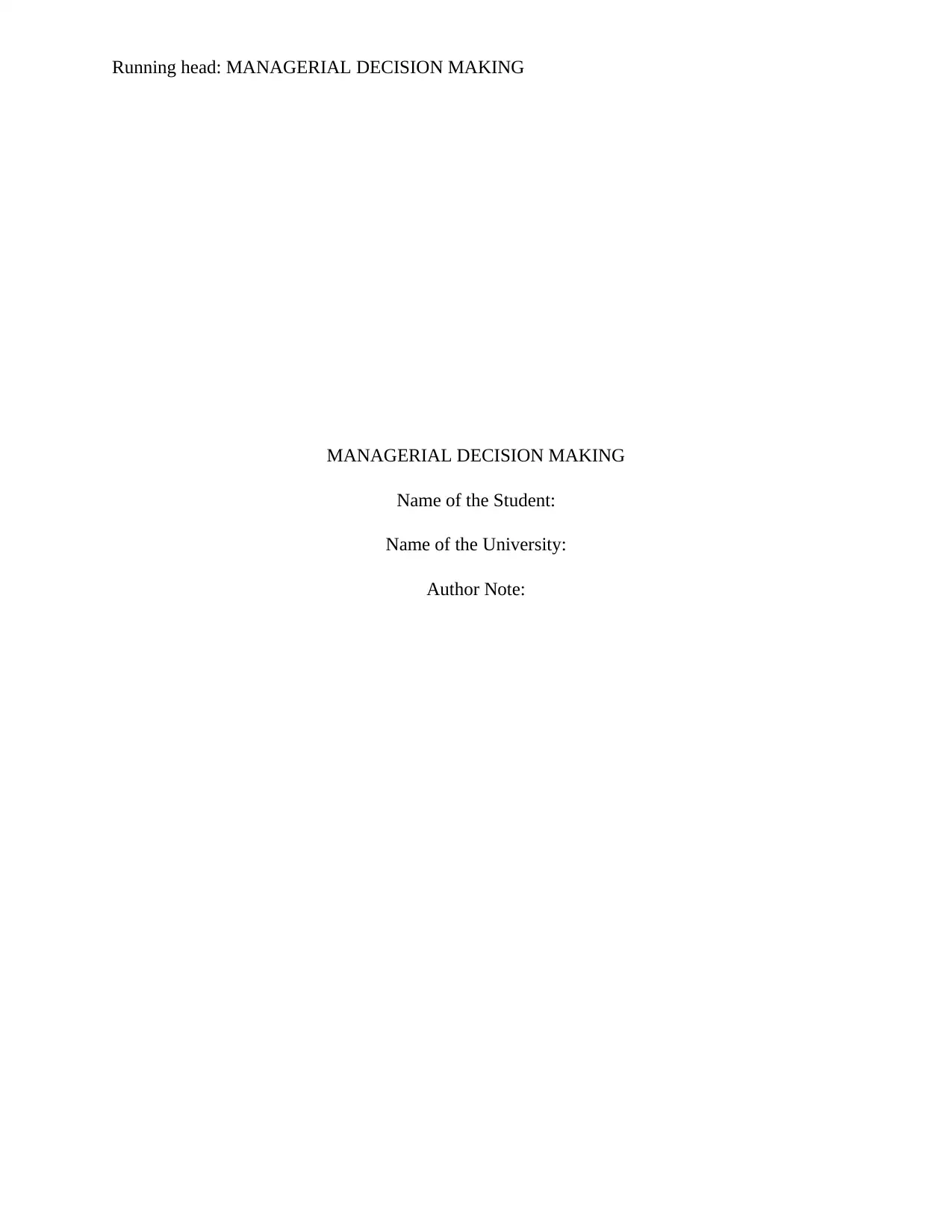
Running head: MANAGERIAL DECISION MAKING
MANAGERIAL DECISION MAKING
Name of the Student:
Name of the University:
Author Note:
MANAGERIAL DECISION MAKING
Name of the Student:
Name of the University:
Author Note:
Paraphrase This Document
Need a fresh take? Get an instant paraphrase of this document with our AI Paraphraser
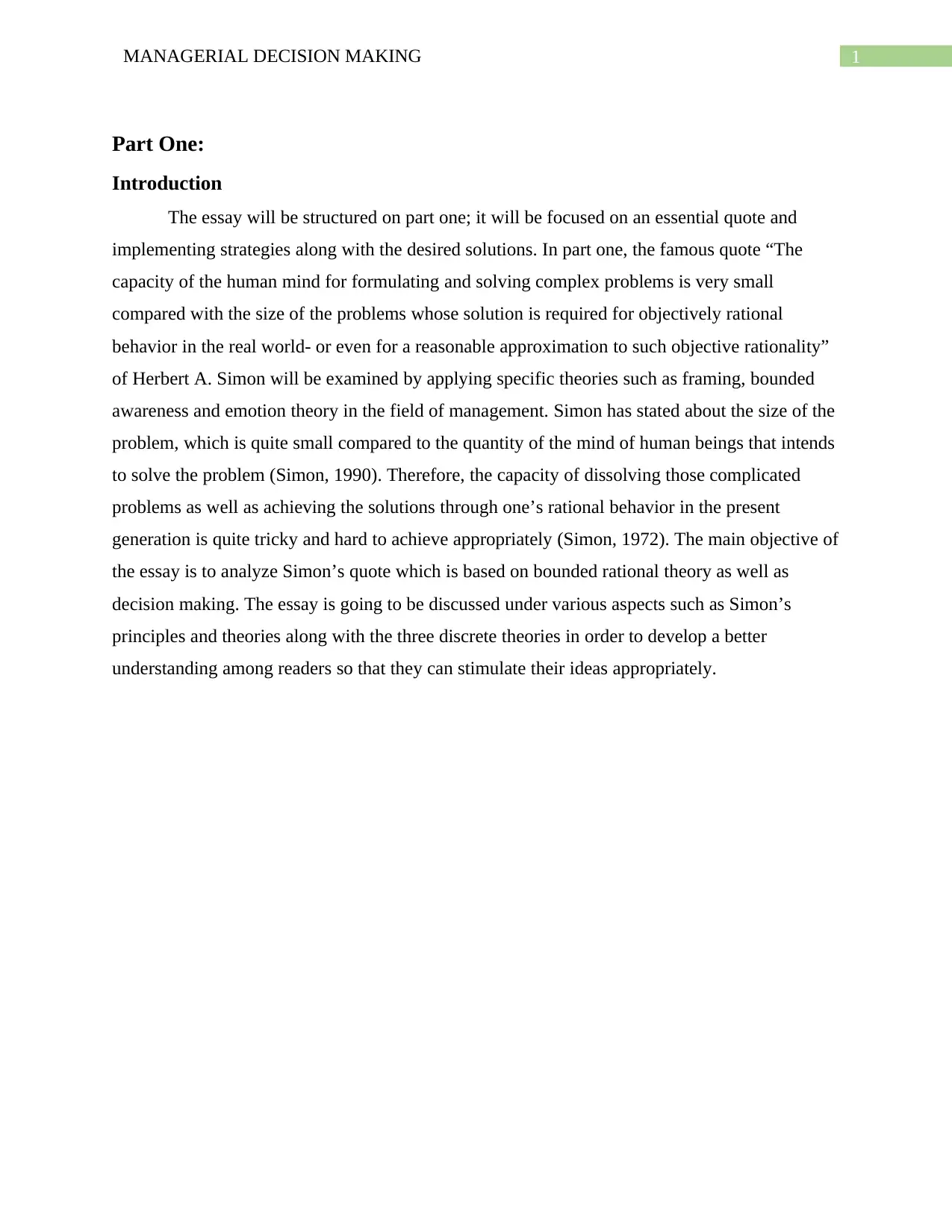
1MANAGERIAL DECISION MAKING
Part One:
Introduction
The essay will be structured on part one; it will be focused on an essential quote and
implementing strategies along with the desired solutions. In part one, the famous quote “The
capacity of the human mind for formulating and solving complex problems is very small
compared with the size of the problems whose solution is required for objectively rational
behavior in the real world- or even for a reasonable approximation to such objective rationality”
of Herbert A. Simon will be examined by applying specific theories such as framing, bounded
awareness and emotion theory in the field of management. Simon has stated about the size of the
problem, which is quite small compared to the quantity of the mind of human beings that intends
to solve the problem (Simon, 1990). Therefore, the capacity of dissolving those complicated
problems as well as achieving the solutions through one’s rational behavior in the present
generation is quite tricky and hard to achieve appropriately (Simon, 1972). The main objective of
the essay is to analyze Simon’s quote which is based on bounded rational theory as well as
decision making. The essay is going to be discussed under various aspects such as Simon’s
principles and theories along with the three discrete theories in order to develop a better
understanding among readers so that they can stimulate their ideas appropriately.
Part One:
Introduction
The essay will be structured on part one; it will be focused on an essential quote and
implementing strategies along with the desired solutions. In part one, the famous quote “The
capacity of the human mind for formulating and solving complex problems is very small
compared with the size of the problems whose solution is required for objectively rational
behavior in the real world- or even for a reasonable approximation to such objective rationality”
of Herbert A. Simon will be examined by applying specific theories such as framing, bounded
awareness and emotion theory in the field of management. Simon has stated about the size of the
problem, which is quite small compared to the quantity of the mind of human beings that intends
to solve the problem (Simon, 1990). Therefore, the capacity of dissolving those complicated
problems as well as achieving the solutions through one’s rational behavior in the present
generation is quite tricky and hard to achieve appropriately (Simon, 1972). The main objective of
the essay is to analyze Simon’s quote which is based on bounded rational theory as well as
decision making. The essay is going to be discussed under various aspects such as Simon’s
principles and theories along with the three discrete theories in order to develop a better
understanding among readers so that they can stimulate their ideas appropriately.
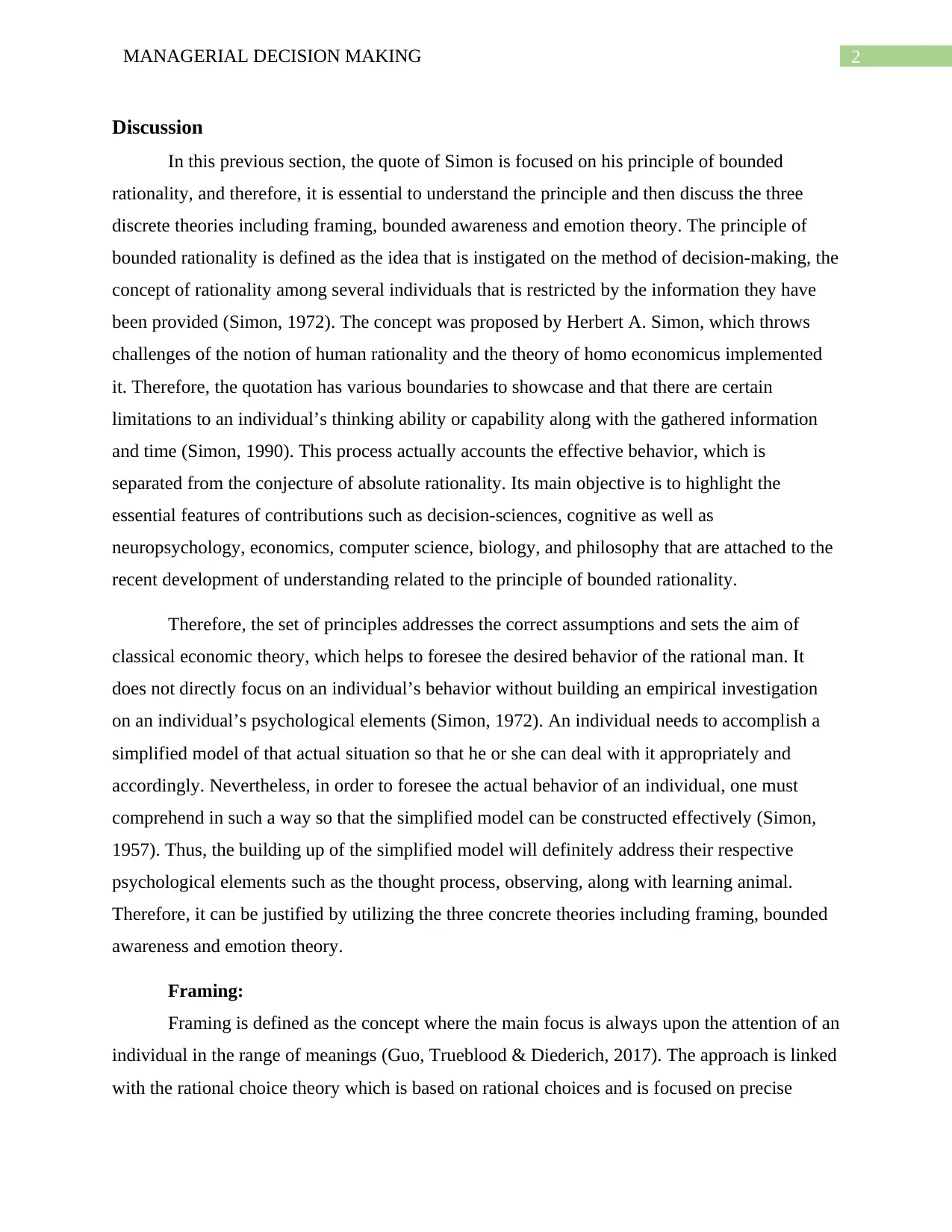
2MANAGERIAL DECISION MAKING
Discussion
In this previous section, the quote of Simon is focused on his principle of bounded
rationality, and therefore, it is essential to understand the principle and then discuss the three
discrete theories including framing, bounded awareness and emotion theory. The principle of
bounded rationality is defined as the idea that is instigated on the method of decision-making, the
concept of rationality among several individuals that is restricted by the information they have
been provided (Simon, 1972). The concept was proposed by Herbert A. Simon, which throws
challenges of the notion of human rationality and the theory of homo economicus implemented
it. Therefore, the quotation has various boundaries to showcase and that there are certain
limitations to an individual’s thinking ability or capability along with the gathered information
and time (Simon, 1990). This process actually accounts the effective behavior, which is
separated from the conjecture of absolute rationality. Its main objective is to highlight the
essential features of contributions such as decision-sciences, cognitive as well as
neuropsychology, economics, computer science, biology, and philosophy that are attached to the
recent development of understanding related to the principle of bounded rationality.
Therefore, the set of principles addresses the correct assumptions and sets the aim of
classical economic theory, which helps to foresee the desired behavior of the rational man. It
does not directly focus on an individual’s behavior without building an empirical investigation
on an individual’s psychological elements (Simon, 1972). An individual needs to accomplish a
simplified model of that actual situation so that he or she can deal with it appropriately and
accordingly. Nevertheless, in order to foresee the actual behavior of an individual, one must
comprehend in such a way so that the simplified model can be constructed effectively (Simon,
1957). Thus, the building up of the simplified model will definitely address their respective
psychological elements such as the thought process, observing, along with learning animal.
Therefore, it can be justified by utilizing the three concrete theories including framing, bounded
awareness and emotion theory.
Framing:
Framing is defined as the concept where the main focus is always upon the attention of an
individual in the range of meanings (Guo, Trueblood & Diederich, 2017). The approach is linked
with the rational choice theory which is based on rational choices and is focused on precise
Discussion
In this previous section, the quote of Simon is focused on his principle of bounded
rationality, and therefore, it is essential to understand the principle and then discuss the three
discrete theories including framing, bounded awareness and emotion theory. The principle of
bounded rationality is defined as the idea that is instigated on the method of decision-making, the
concept of rationality among several individuals that is restricted by the information they have
been provided (Simon, 1972). The concept was proposed by Herbert A. Simon, which throws
challenges of the notion of human rationality and the theory of homo economicus implemented
it. Therefore, the quotation has various boundaries to showcase and that there are certain
limitations to an individual’s thinking ability or capability along with the gathered information
and time (Simon, 1990). This process actually accounts the effective behavior, which is
separated from the conjecture of absolute rationality. Its main objective is to highlight the
essential features of contributions such as decision-sciences, cognitive as well as
neuropsychology, economics, computer science, biology, and philosophy that are attached to the
recent development of understanding related to the principle of bounded rationality.
Therefore, the set of principles addresses the correct assumptions and sets the aim of
classical economic theory, which helps to foresee the desired behavior of the rational man. It
does not directly focus on an individual’s behavior without building an empirical investigation
on an individual’s psychological elements (Simon, 1972). An individual needs to accomplish a
simplified model of that actual situation so that he or she can deal with it appropriately and
accordingly. Nevertheless, in order to foresee the actual behavior of an individual, one must
comprehend in such a way so that the simplified model can be constructed effectively (Simon,
1957). Thus, the building up of the simplified model will definitely address their respective
psychological elements such as the thought process, observing, along with learning animal.
Therefore, it can be justified by utilizing the three concrete theories including framing, bounded
awareness and emotion theory.
Framing:
Framing is defined as the concept where the main focus is always upon the attention of an
individual in the range of meanings (Guo, Trueblood & Diederich, 2017). The approach is linked
with the rational choice theory which is based on rational choices and is focused on precise
⊘ This is a preview!⊘
Do you want full access?
Subscribe today to unlock all pages.

Trusted by 1+ million students worldwide
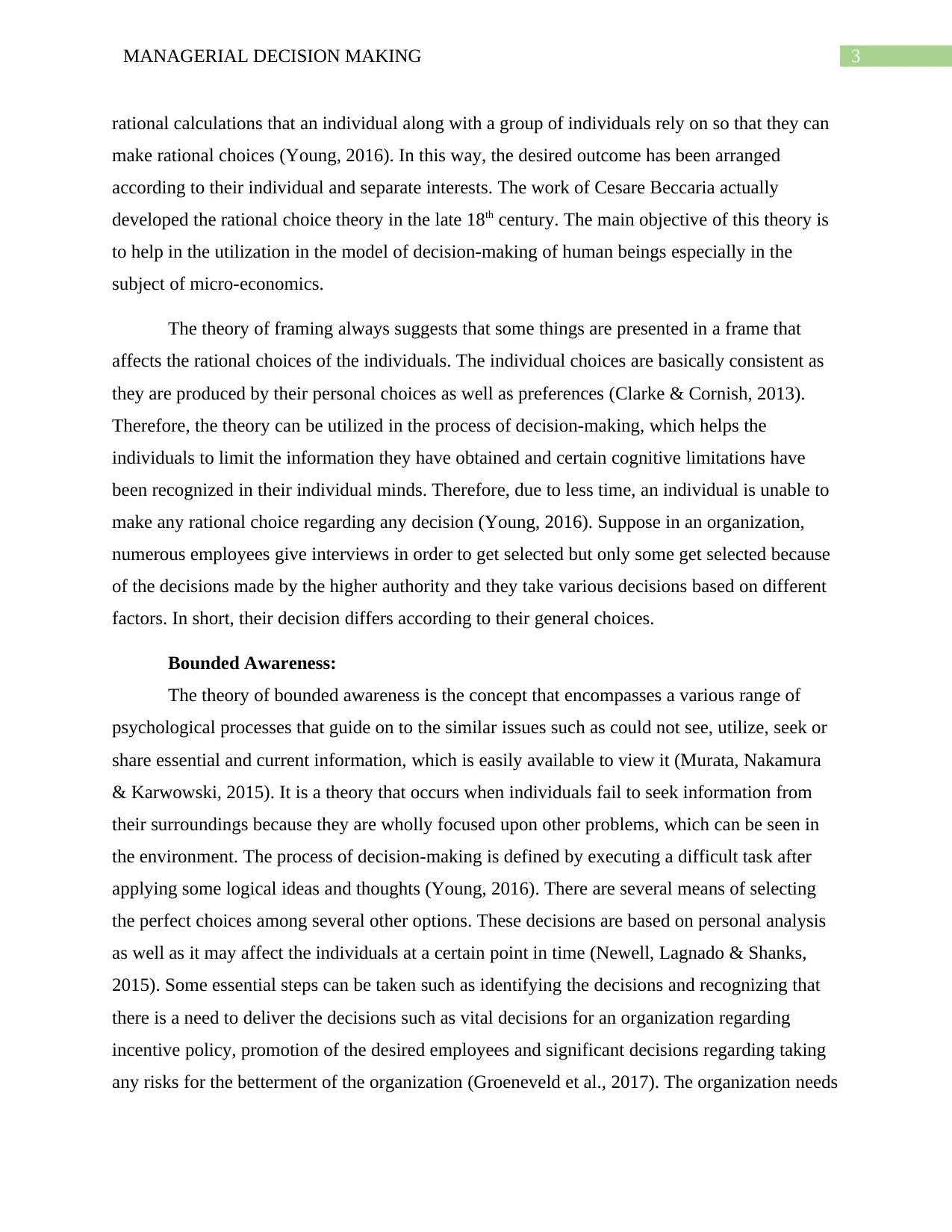
3MANAGERIAL DECISION MAKING
rational calculations that an individual along with a group of individuals rely on so that they can
make rational choices (Young, 2016). In this way, the desired outcome has been arranged
according to their individual and separate interests. The work of Cesare Beccaria actually
developed the rational choice theory in the late 18th century. The main objective of this theory is
to help in the utilization in the model of decision-making of human beings especially in the
subject of micro-economics.
The theory of framing always suggests that some things are presented in a frame that
affects the rational choices of the individuals. The individual choices are basically consistent as
they are produced by their personal choices as well as preferences (Clarke & Cornish, 2013).
Therefore, the theory can be utilized in the process of decision-making, which helps the
individuals to limit the information they have obtained and certain cognitive limitations have
been recognized in their individual minds. Therefore, due to less time, an individual is unable to
make any rational choice regarding any decision (Young, 2016). Suppose in an organization,
numerous employees give interviews in order to get selected but only some get selected because
of the decisions made by the higher authority and they take various decisions based on different
factors. In short, their decision differs according to their general choices.
Bounded Awareness:
The theory of bounded awareness is the concept that encompasses a various range of
psychological processes that guide on to the similar issues such as could not see, utilize, seek or
share essential and current information, which is easily available to view it (Murata, Nakamura
& Karwowski, 2015). It is a theory that occurs when individuals fail to seek information from
their surroundings because they are wholly focused upon other problems, which can be seen in
the environment. The process of decision-making is defined by executing a difficult task after
applying some logical ideas and thoughts (Young, 2016). There are several means of selecting
the perfect choices among several other options. These decisions are based on personal analysis
as well as it may affect the individuals at a certain point in time (Newell, Lagnado & Shanks,
2015). Some essential steps can be taken such as identifying the decisions and recognizing that
there is a need to deliver the decisions such as vital decisions for an organization regarding
incentive policy, promotion of the desired employees and significant decisions regarding taking
any risks for the betterment of the organization (Groeneveld et al., 2017). The organization needs
rational calculations that an individual along with a group of individuals rely on so that they can
make rational choices (Young, 2016). In this way, the desired outcome has been arranged
according to their individual and separate interests. The work of Cesare Beccaria actually
developed the rational choice theory in the late 18th century. The main objective of this theory is
to help in the utilization in the model of decision-making of human beings especially in the
subject of micro-economics.
The theory of framing always suggests that some things are presented in a frame that
affects the rational choices of the individuals. The individual choices are basically consistent as
they are produced by their personal choices as well as preferences (Clarke & Cornish, 2013).
Therefore, the theory can be utilized in the process of decision-making, which helps the
individuals to limit the information they have obtained and certain cognitive limitations have
been recognized in their individual minds. Therefore, due to less time, an individual is unable to
make any rational choice regarding any decision (Young, 2016). Suppose in an organization,
numerous employees give interviews in order to get selected but only some get selected because
of the decisions made by the higher authority and they take various decisions based on different
factors. In short, their decision differs according to their general choices.
Bounded Awareness:
The theory of bounded awareness is the concept that encompasses a various range of
psychological processes that guide on to the similar issues such as could not see, utilize, seek or
share essential and current information, which is easily available to view it (Murata, Nakamura
& Karwowski, 2015). It is a theory that occurs when individuals fail to seek information from
their surroundings because they are wholly focused upon other problems, which can be seen in
the environment. The process of decision-making is defined by executing a difficult task after
applying some logical ideas and thoughts (Young, 2016). There are several means of selecting
the perfect choices among several other options. These decisions are based on personal analysis
as well as it may affect the individuals at a certain point in time (Newell, Lagnado & Shanks,
2015). Some essential steps can be taken such as identifying the decisions and recognizing that
there is a need to deliver the decisions such as vital decisions for an organization regarding
incentive policy, promotion of the desired employees and significant decisions regarding taking
any risks for the betterment of the organization (Groeneveld et al., 2017). The organization needs
Paraphrase This Document
Need a fresh take? Get an instant paraphrase of this document with our AI Paraphraser
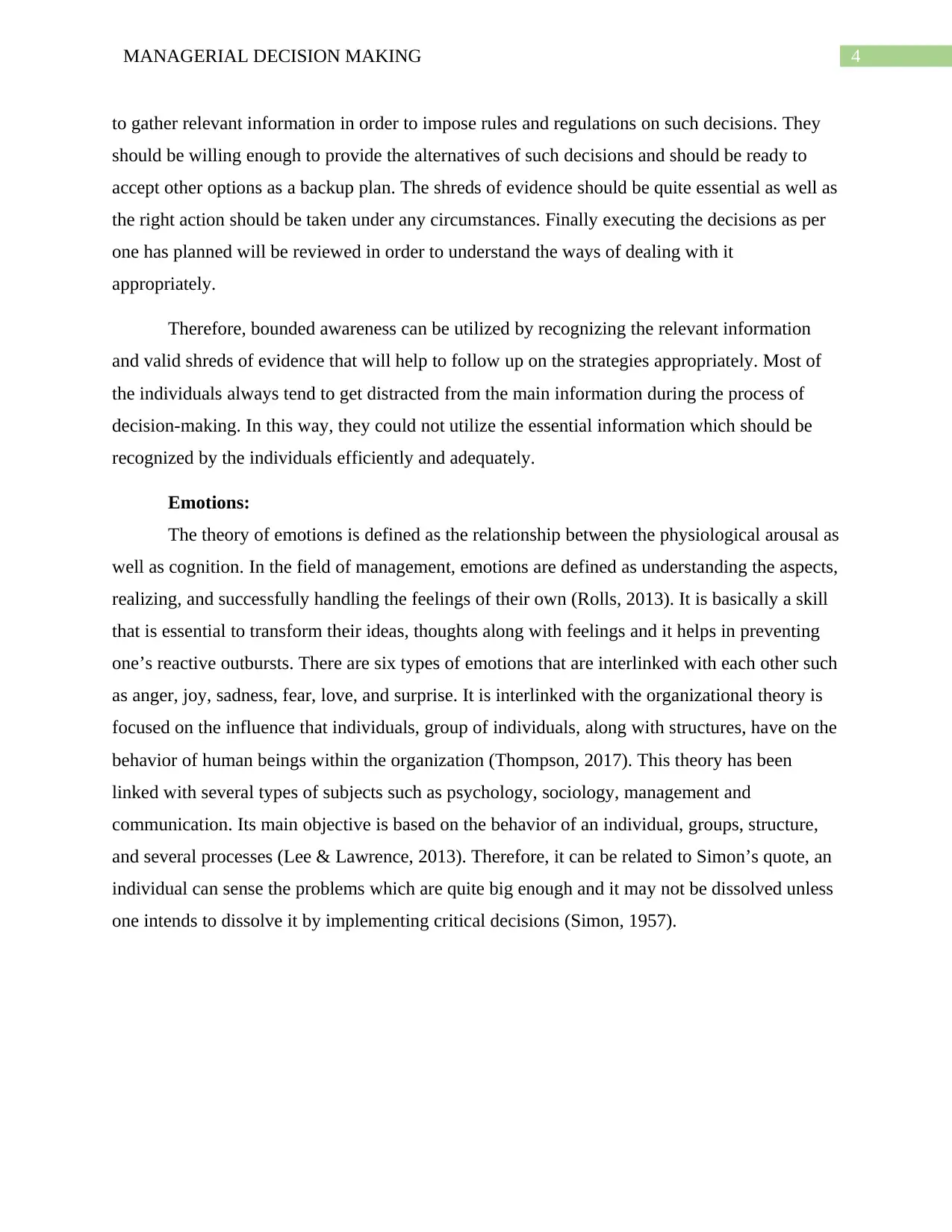
4MANAGERIAL DECISION MAKING
to gather relevant information in order to impose rules and regulations on such decisions. They
should be willing enough to provide the alternatives of such decisions and should be ready to
accept other options as a backup plan. The shreds of evidence should be quite essential as well as
the right action should be taken under any circumstances. Finally executing the decisions as per
one has planned will be reviewed in order to understand the ways of dealing with it
appropriately.
Therefore, bounded awareness can be utilized by recognizing the relevant information
and valid shreds of evidence that will help to follow up on the strategies appropriately. Most of
the individuals always tend to get distracted from the main information during the process of
decision-making. In this way, they could not utilize the essential information which should be
recognized by the individuals efficiently and adequately.
Emotions:
The theory of emotions is defined as the relationship between the physiological arousal as
well as cognition. In the field of management, emotions are defined as understanding the aspects,
realizing, and successfully handling the feelings of their own (Rolls, 2013). It is basically a skill
that is essential to transform their ideas, thoughts along with feelings and it helps in preventing
one’s reactive outbursts. There are six types of emotions that are interlinked with each other such
as anger, joy, sadness, fear, love, and surprise. It is interlinked with the organizational theory is
focused on the influence that individuals, group of individuals, along with structures, have on the
behavior of human beings within the organization (Thompson, 2017). This theory has been
linked with several types of subjects such as psychology, sociology, management and
communication. Its main objective is based on the behavior of an individual, groups, structure,
and several processes (Lee & Lawrence, 2013). Therefore, it can be related to Simon’s quote, an
individual can sense the problems which are quite big enough and it may not be dissolved unless
one intends to dissolve it by implementing critical decisions (Simon, 1957).
to gather relevant information in order to impose rules and regulations on such decisions. They
should be willing enough to provide the alternatives of such decisions and should be ready to
accept other options as a backup plan. The shreds of evidence should be quite essential as well as
the right action should be taken under any circumstances. Finally executing the decisions as per
one has planned will be reviewed in order to understand the ways of dealing with it
appropriately.
Therefore, bounded awareness can be utilized by recognizing the relevant information
and valid shreds of evidence that will help to follow up on the strategies appropriately. Most of
the individuals always tend to get distracted from the main information during the process of
decision-making. In this way, they could not utilize the essential information which should be
recognized by the individuals efficiently and adequately.
Emotions:
The theory of emotions is defined as the relationship between the physiological arousal as
well as cognition. In the field of management, emotions are defined as understanding the aspects,
realizing, and successfully handling the feelings of their own (Rolls, 2013). It is basically a skill
that is essential to transform their ideas, thoughts along with feelings and it helps in preventing
one’s reactive outbursts. There are six types of emotions that are interlinked with each other such
as anger, joy, sadness, fear, love, and surprise. It is interlinked with the organizational theory is
focused on the influence that individuals, group of individuals, along with structures, have on the
behavior of human beings within the organization (Thompson, 2017). This theory has been
linked with several types of subjects such as psychology, sociology, management and
communication. Its main objective is based on the behavior of an individual, groups, structure,
and several processes (Lee & Lawrence, 2013). Therefore, it can be related to Simon’s quote, an
individual can sense the problems which are quite big enough and it may not be dissolved unless
one intends to dissolve it by implementing critical decisions (Simon, 1957).
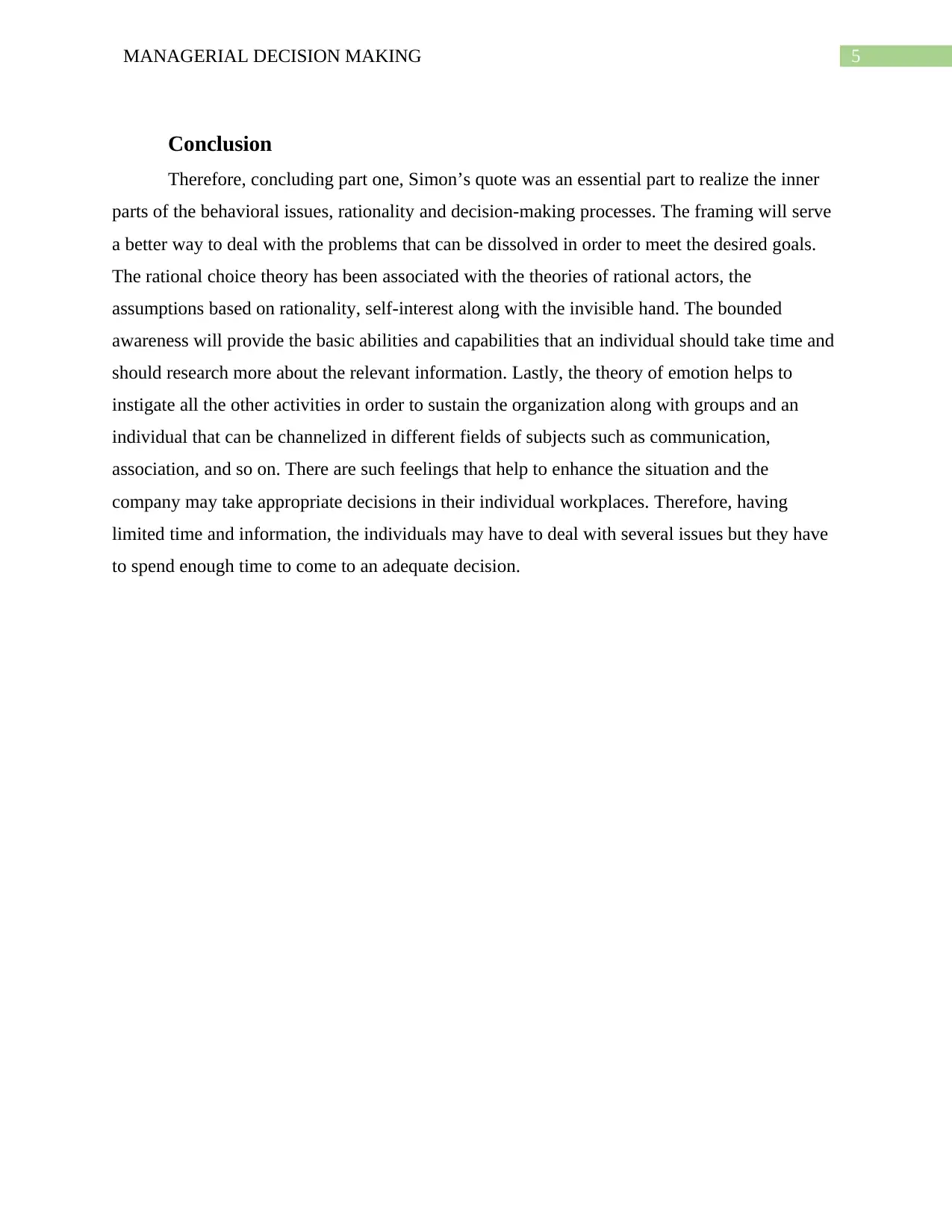
5MANAGERIAL DECISION MAKING
Conclusion
Therefore, concluding part one, Simon’s quote was an essential part to realize the inner
parts of the behavioral issues, rationality and decision-making processes. The framing will serve
a better way to deal with the problems that can be dissolved in order to meet the desired goals.
The rational choice theory has been associated with the theories of rational actors, the
assumptions based on rationality, self-interest along with the invisible hand. The bounded
awareness will provide the basic abilities and capabilities that an individual should take time and
should research more about the relevant information. Lastly, the theory of emotion helps to
instigate all the other activities in order to sustain the organization along with groups and an
individual that can be channelized in different fields of subjects such as communication,
association, and so on. There are such feelings that help to enhance the situation and the
company may take appropriate decisions in their individual workplaces. Therefore, having
limited time and information, the individuals may have to deal with several issues but they have
to spend enough time to come to an adequate decision.
Conclusion
Therefore, concluding part one, Simon’s quote was an essential part to realize the inner
parts of the behavioral issues, rationality and decision-making processes. The framing will serve
a better way to deal with the problems that can be dissolved in order to meet the desired goals.
The rational choice theory has been associated with the theories of rational actors, the
assumptions based on rationality, self-interest along with the invisible hand. The bounded
awareness will provide the basic abilities and capabilities that an individual should take time and
should research more about the relevant information. Lastly, the theory of emotion helps to
instigate all the other activities in order to sustain the organization along with groups and an
individual that can be channelized in different fields of subjects such as communication,
association, and so on. There are such feelings that help to enhance the situation and the
company may take appropriate decisions in their individual workplaces. Therefore, having
limited time and information, the individuals may have to deal with several issues but they have
to spend enough time to come to an adequate decision.
⊘ This is a preview!⊘
Do you want full access?
Subscribe today to unlock all pages.

Trusted by 1+ million students worldwide
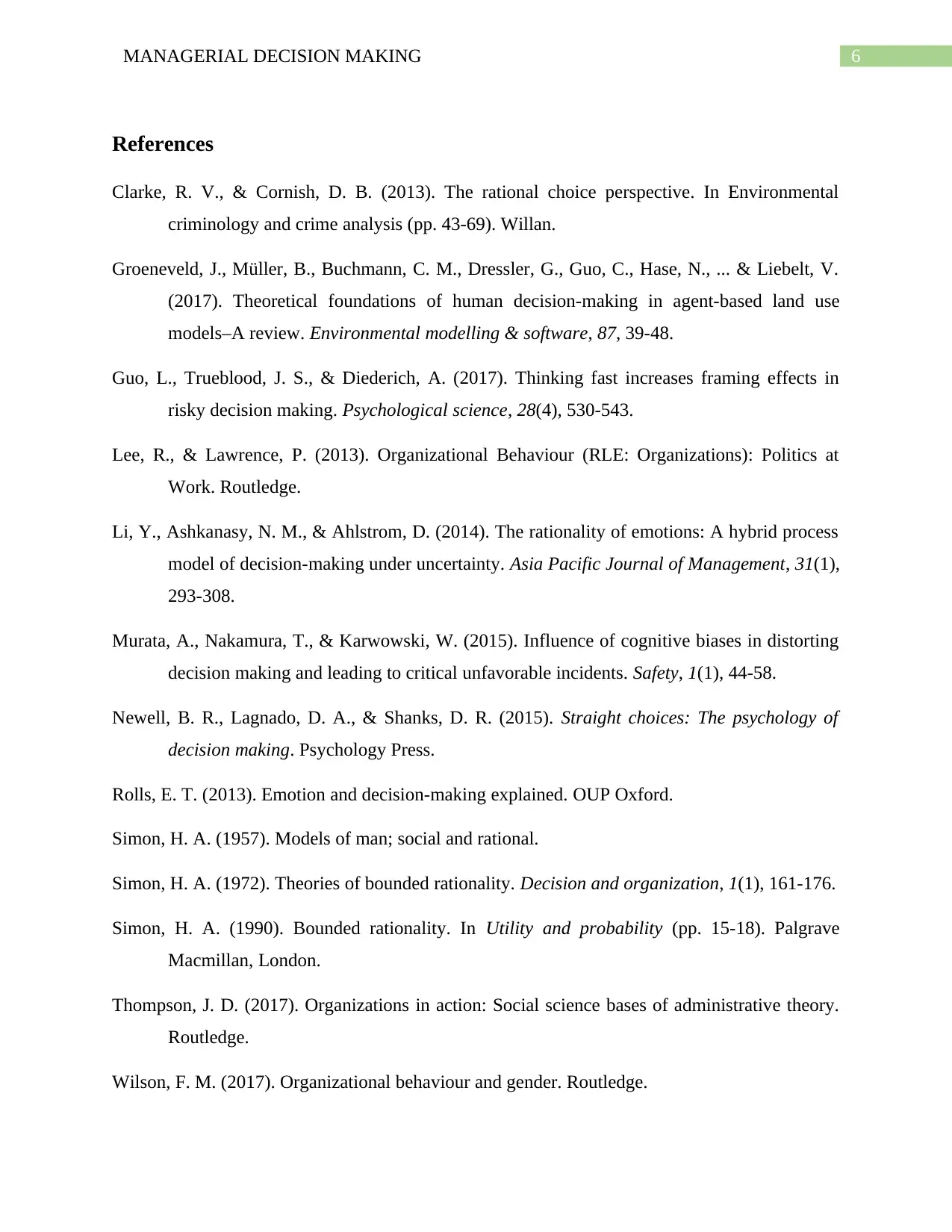
6MANAGERIAL DECISION MAKING
References
Clarke, R. V., & Cornish, D. B. (2013). The rational choice perspective. In Environmental
criminology and crime analysis (pp. 43-69). Willan.
Groeneveld, J., Müller, B., Buchmann, C. M., Dressler, G., Guo, C., Hase, N., ... & Liebelt, V.
(2017). Theoretical foundations of human decision-making in agent-based land use
models–A review. Environmental modelling & software, 87, 39-48.
Guo, L., Trueblood, J. S., & Diederich, A. (2017). Thinking fast increases framing effects in
risky decision making. Psychological science, 28(4), 530-543.
Lee, R., & Lawrence, P. (2013). Organizational Behaviour (RLE: Organizations): Politics at
Work. Routledge.
Li, Y., Ashkanasy, N. M., & Ahlstrom, D. (2014). The rationality of emotions: A hybrid process
model of decision-making under uncertainty. Asia Pacific Journal of Management, 31(1),
293-308.
Murata, A., Nakamura, T., & Karwowski, W. (2015). Influence of cognitive biases in distorting
decision making and leading to critical unfavorable incidents. Safety, 1(1), 44-58.
Newell, B. R., Lagnado, D. A., & Shanks, D. R. (2015). Straight choices: The psychology of
decision making. Psychology Press.
Rolls, E. T. (2013). Emotion and decision-making explained. OUP Oxford.
Simon, H. A. (1957). Models of man; social and rational.
Simon, H. A. (1972). Theories of bounded rationality. Decision and organization, 1(1), 161-176.
Simon, H. A. (1990). Bounded rationality. In Utility and probability (pp. 15-18). Palgrave
Macmillan, London.
Thompson, J. D. (2017). Organizations in action: Social science bases of administrative theory.
Routledge.
Wilson, F. M. (2017). Organizational behaviour and gender. Routledge.
References
Clarke, R. V., & Cornish, D. B. (2013). The rational choice perspective. In Environmental
criminology and crime analysis (pp. 43-69). Willan.
Groeneveld, J., Müller, B., Buchmann, C. M., Dressler, G., Guo, C., Hase, N., ... & Liebelt, V.
(2017). Theoretical foundations of human decision-making in agent-based land use
models–A review. Environmental modelling & software, 87, 39-48.
Guo, L., Trueblood, J. S., & Diederich, A. (2017). Thinking fast increases framing effects in
risky decision making. Psychological science, 28(4), 530-543.
Lee, R., & Lawrence, P. (2013). Organizational Behaviour (RLE: Organizations): Politics at
Work. Routledge.
Li, Y., Ashkanasy, N. M., & Ahlstrom, D. (2014). The rationality of emotions: A hybrid process
model of decision-making under uncertainty. Asia Pacific Journal of Management, 31(1),
293-308.
Murata, A., Nakamura, T., & Karwowski, W. (2015). Influence of cognitive biases in distorting
decision making and leading to critical unfavorable incidents. Safety, 1(1), 44-58.
Newell, B. R., Lagnado, D. A., & Shanks, D. R. (2015). Straight choices: The psychology of
decision making. Psychology Press.
Rolls, E. T. (2013). Emotion and decision-making explained. OUP Oxford.
Simon, H. A. (1957). Models of man; social and rational.
Simon, H. A. (1972). Theories of bounded rationality. Decision and organization, 1(1), 161-176.
Simon, H. A. (1990). Bounded rationality. In Utility and probability (pp. 15-18). Palgrave
Macmillan, London.
Thompson, J. D. (2017). Organizations in action: Social science bases of administrative theory.
Routledge.
Wilson, F. M. (2017). Organizational behaviour and gender. Routledge.
Paraphrase This Document
Need a fresh take? Get an instant paraphrase of this document with our AI Paraphraser
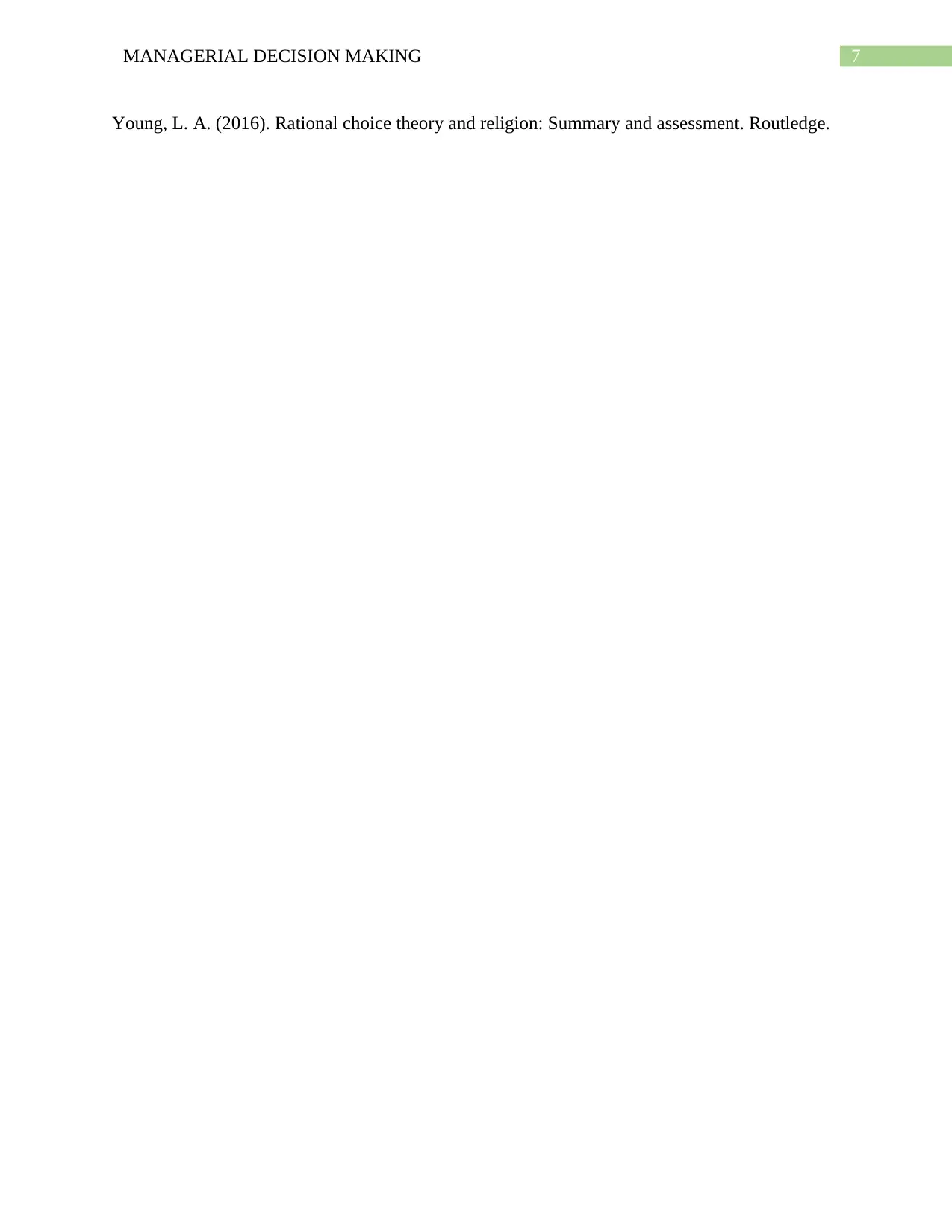
7MANAGERIAL DECISION MAKING
Young, L. A. (2016). Rational choice theory and religion: Summary and assessment. Routledge.
Young, L. A. (2016). Rational choice theory and religion: Summary and assessment. Routledge.
1 out of 8
Related Documents
Your All-in-One AI-Powered Toolkit for Academic Success.
+13062052269
info@desklib.com
Available 24*7 on WhatsApp / Email
![[object Object]](/_next/static/media/star-bottom.7253800d.svg)
Unlock your academic potential
Copyright © 2020–2025 A2Z Services. All Rights Reserved. Developed and managed by ZUCOL.





